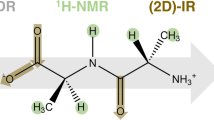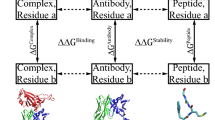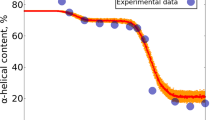Abstract
Many short synthetic peptides have now been shown to induce antibodies reactive with their cognate sequences in the intact folded protein1–8. Aside from the usefulness of such antibodies as site-specific reagents, the frequency with which this recognition occurs has raised several theoretical issues, the central one being that of how an antibody to a short synthetic peptide, which represents one of the most disordered states of a site in a protein, can react with the more ordered version of the same sequence in the folded protein. This apparent paradox can be resolved if the target site on the protein approaches disorder or if the peptide in solution or on a carrier adopts, with significant frequency, a conformation compatible with that of the cognate site in the protein. Various studies already suggest that antigenic sites in proteins correspond to regions of high atomic mobility1,9–15. We now show, using high-field nuclear magnetic resonance (NMR) spectroscopy, that a nonapeptide selected by several monoclonal antibodies as the immunodominant site of a 36-amino-acid immunogen (residues 75–110 of influenza virus haemagglutinin16,17) adopts a highly populated type-II reverse-turn conformation in water. This suggests that in this case the antibodies have selected a sequence possessing a conformational preference. Apart from helping us to understand immunological recognition, anti-peptide antibodies may provide reagents of sufficient precision for an immunological approach to the problem of protein folding18–23.
This is a preview of subscription content, access via your institution
Access options
Subscribe to this journal
Receive 51 print issues and online access
$199.00 per year
only $3.90 per issue
Buy this article
- Purchase on Springer Link
- Instant access to full article PDF
Prices may be subject to local taxes which are calculated during checkout
Similar content being viewed by others
References
Lerner, R. A. Adv. Immun. 36, 1–44 (1984).
Lerner, R. A. Nature 299, 592–596 (1982).
Enea, V. et al. Science 225, 628–630 (1984).
Ballou, W. R. et al. Science 228, 996–999 (1985).
Chow, M., Yabrov, R., Bittle, J., Hogle, J. & Baltimore, D. Proc. natn. Acad. Sci. U.S.A. 82, 910–914 (1985).
Kris, R. M. et al. Cell 40, 619–625 (1985).
Lamb, R. A., Zebedee, S. L. & Richardson, C. D. Cell 40, 627–633 (1985).
Schmidt, M. A., O'Hanley, P. & Schoolnik, G. K. J. exp. Med. 161, 705–717 (1984).
Artymiuk, P. J. et al. Nature 280, 563–568 (1979).
Moore, G. R. & Williams, R. J. P. Eur. J. Biochem. 103, 543–550 (1980).
Westhof, E. et al. Nature 311, 123–126 (1984).
Tainer, J. A. et al. Nature 312, 127–133 (1984).
Williams, R. J. P. & Moore, G. R. Trends biochem. Sci. 10, 96–97 (1985).
Tainer, J. A., Getzoff, E. D., Paterson, Y., Olson, A. J. & Lerner, R. A. A. Rev. Immun. 3, 501–535 (1985).
Hirayama, A., Takagaki, Y. & Karush, F. J. Immun. 134, 3241–3247 (1985).
Wilson, I. A. et al. Cell 37, 767–778 (1984).
Wilson, I. A., Wiley, D. C. & Skehel, J. J. Nature 289, 366–373 (1981).
Sachs, D. H., Schechter, A. N., Eastlake, A. & Anfinsen, C. B. Proc. natn. Acad. Sci. U.S.A. 69, 3790–3794 (1972).
Sachs, D. H., Schechter, A. N., Eastlake, A. & Anfinsen, C. B. J. Immun. 109, 1300–1310 (1972).
Anfinsen, C. B. & Scheraga, H. A. Adv. Protein Chem. 29, 205–300 (1975).
Wetlaufer, D. B. Adv. Protein Chem. 34, 61–92 (1981).
Teale, J. M. & Benjamin, D. C. J. biol. Chem. 251, 4609–4615 (1976).
Celada, F., Fowler, A. V. & Zabin, I. Biochemistry 17, 5156–5160 (1978).
Aue, W. P., Bartholdi, E. & Ernst, R. R. J. chem. Phys. 64, 2229–2246 (1976).
Bax, A. & Freeman, R. J. magn. Reson. 44, 542–561 (1981).
Rance, M. et al. Biochem. biophys. Res. Commun. 117, 479–485 (1983).
Grathwohl, C. & Wuthrich, K. Biopolymers 20, 2623–2633 (1981).
Deslauriers, R. & Smith, I. C. P. in Biological Magnetic Resonance Vol. 2 (eds Berliner, L. J. & Reuben, J.) 243–344 (Plenum, New York, 1980).
Urry, D. W. & Ohnishi, M. in Spectroscopic Approaches to Biomolecular Conformation (ed. Urry, D. W.) 263–300 (American Medical Association, Chicago, 1970).
Shenderovich, M. D., Nikiforovich, G. V. & Chipens, G. I. J. magn. Reson. 59, 1–12 (1984).
Bystrov, V. F. Prog. NMR Spectrosc. 10, 41–81 (1976).
Crumpton, M. J. & Small, P. A. J. molec. Biol. 26, 143–146 (1967).
Conway-Jacobs, A., Schechter, B. & Sela, M. Biochemistry 9, 4870–4875 (1970).
Schechter, B., Conway-Jacobs, A. & Sela, M. Eur. J. Biochem. 20, 321–324 (1971).
Houghten, R. A. Proc. natn. Acad. Sci. U.S.A. 82, 5131–5135 (1985).
Guittet, E., Delsuc, M. A. & Lallemand, J. Y. J. Am. chem. Soc. 106, 4278–4279 (1984).
Plateau, P. & Gueron, M. J. Am. chem. Soc. 104, 7311–7312 (1982).
Benoiton, L. Can. J. Chem. 40, 570–572 (1962).
Itoh, M., Hagiwara, D. & Kamiya, T. Tetrahedron Lett. 49, 4393–4394 (1975).
Mendz, G. L. & Moore, W. J. Biochem. J. 229, 305–313 (1985).
Author information
Authors and Affiliations
Rights and permissions
About this article
Cite this article
Jane Dyson, H., Cross, K., Houghten, R. et al. The immunodominant site of a synthetic immunogen has a conformational preference in water for a type-II reverse turn. Nature 318, 480–483 (1985). https://doi.org/10.1038/318480a0
Received:
Accepted:
Issue Date:
DOI: https://doi.org/10.1038/318480a0
This article is cited by
-
Perspective: the essential role of NMR in the discovery and characterization of intrinsically disordered proteins
Journal of Biomolecular NMR (2019)
-
T1BT* structural study of an anti-plasmodial peptide through NMR and molecular dynamics
Malaria Journal (2013)
-
Structure of antibody hypervariable loops reproduced by a conformational search algorithm
Nature (1988)
-
A peptide model of a protein folding intermediate
Nature (1988)
-
The functions of structure and dynamics in proteins, peptides and metal ion complexes and their relationships to biological recognition and the handling of information
Carlsberg Research Communications (1987)
Comments
By submitting a comment you agree to abide by our Terms and Community Guidelines. If you find something abusive or that does not comply with our terms or guidelines please flag it as inappropriate.



